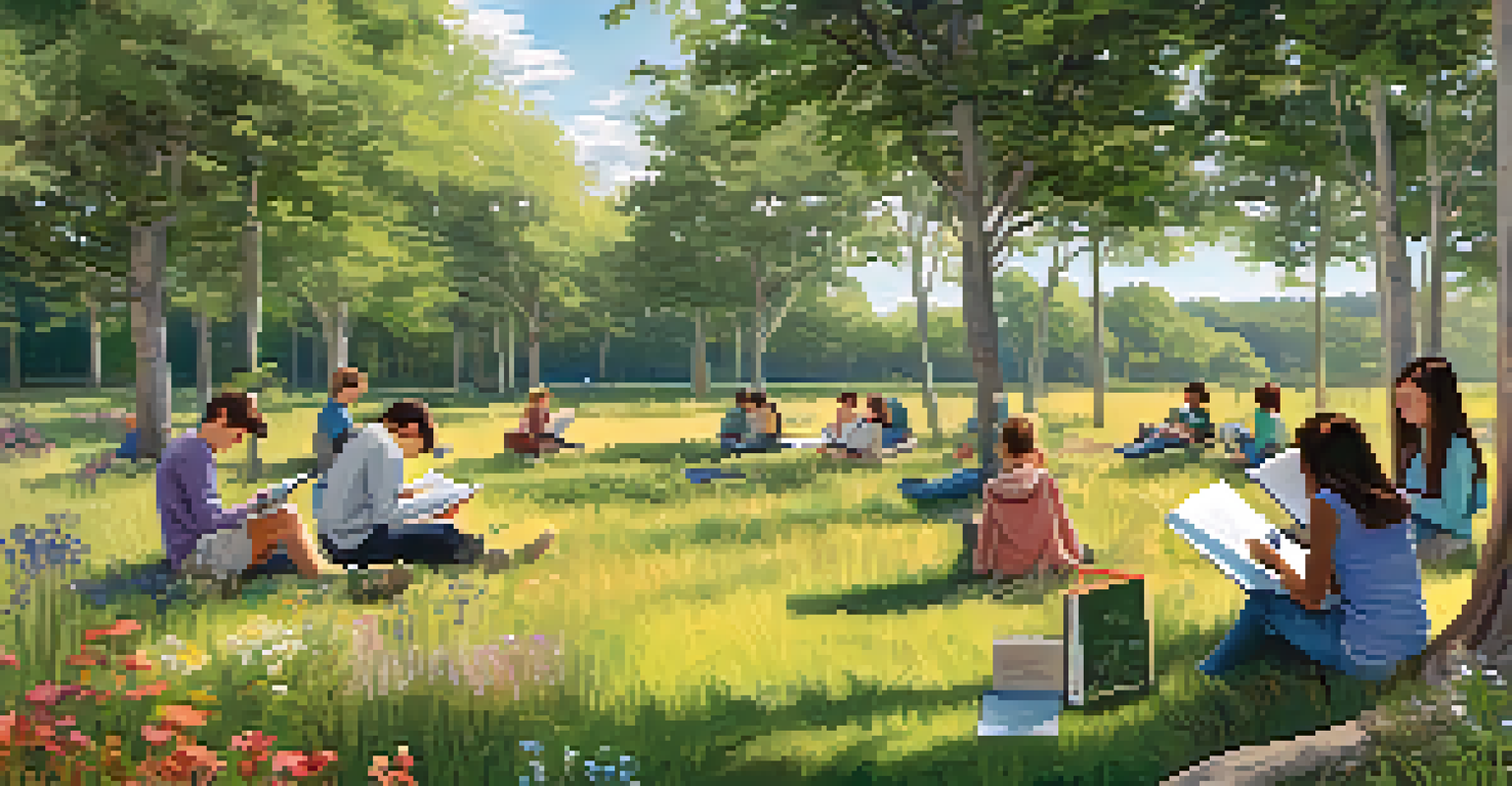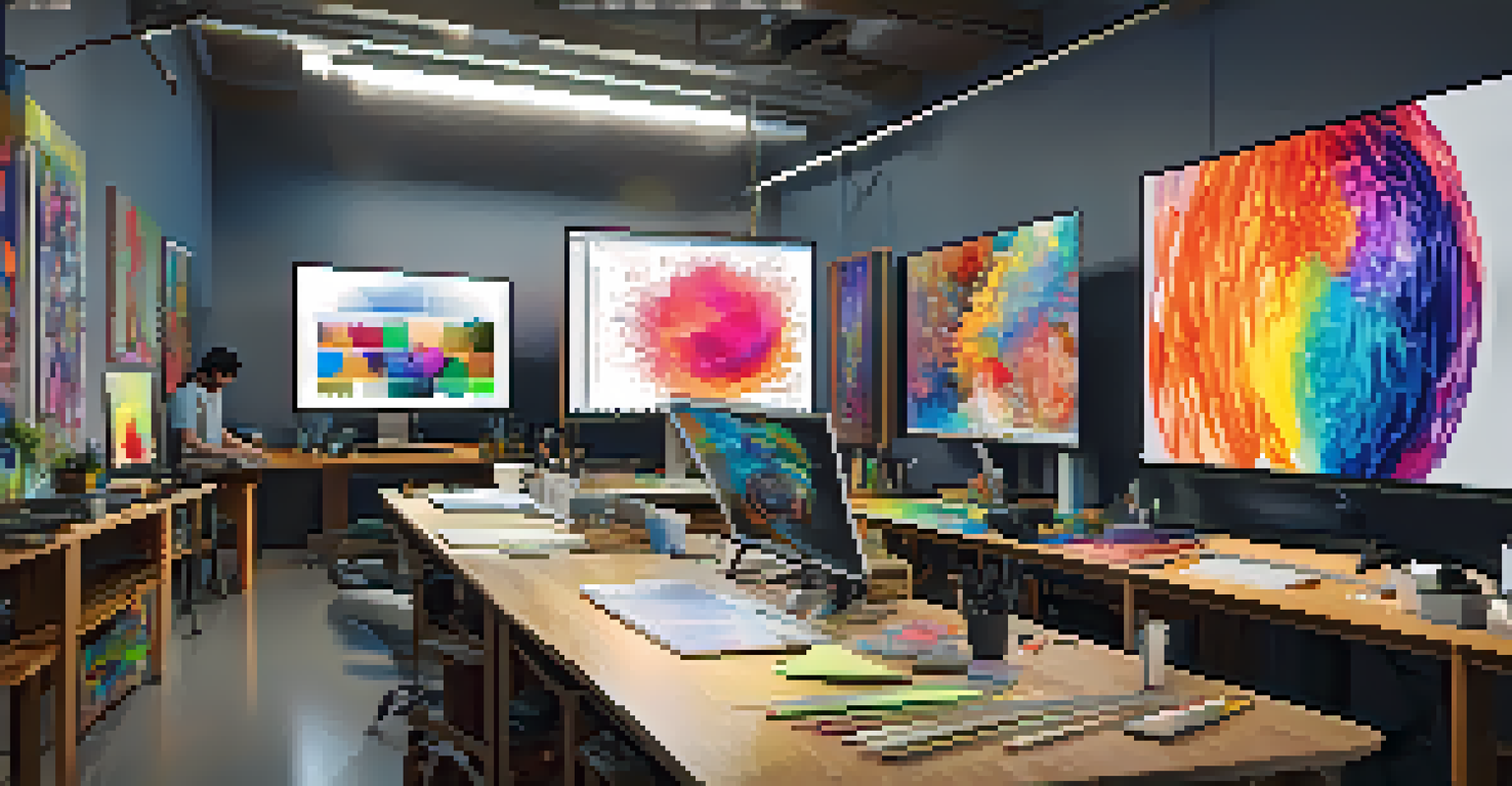Utilizing Art to Teach Scientific Concepts in STEAM

The Intersection of Art and Science in Education
Art and science might seem like distant cousins, but they share a creative bond that can enhance learning. The STEAM approach—integrating Science, Technology, Engineering, Arts, and Mathematics—encourages students to see connections between these fields. By blending artistic expression with scientific inquiry, educators can create a richer learning experience that fosters critical thinking and innovation.
Art is the most beautiful of all lies; it is a lie that enables us to understand the truth of the world.
For instance, students can explore the principles of physics through sculpture, understanding balance and gravity while engaging their creative instincts. This hands-on approach not only makes science more relatable but also opens up new avenues for exploration and expression. The fusion of these disciplines encourages students to think outside the box and develop a passion for both art and science.
Moreover, incorporating art into science education helps cater to diverse learning styles. Visual learners may grasp concepts better through artistic representation, while kinesthetic learners can benefit from hands-on projects. By embracing this interdisciplinary approach, educators can create a more inclusive and stimulating classroom environment.
Using Visual Arts to Illustrate Scientific Ideas
Visual arts serve as a powerful tool for illustrating complex scientific concepts. For example, students can create infographics or posters that break down the process of photosynthesis, making it easier to digest. These visual representations not only aid comprehension but also allow students to engage with the material creatively.

Furthermore, artists like Leonardo da Vinci have historically combined art with scientific observation, showing how sketches can capture anatomical details or engineering designs. By encouraging students to draw their interpretations of scientific phenomena, educators can inspire them to observe the world with a more inquisitive eye. This practice fosters a deeper appreciation for both art and science.
Art Enhances Science Learning
Integrating art into science education fosters creativity and critical thinking, enriching the learning experience.
Additionally, art projects can help students visualize abstract ideas, such as molecular structures or the vastness of space. By creating models or 3D representations, learners can better understand the relationships between different elements and systems. This hands-on approach not only solidifies their knowledge but also makes learning a more enjoyable experience.
Incorporating Performance Arts in Science Education
Performance arts, including drama and dance, offer unique ways to engage students with scientific concepts. For instance, students can act out the water cycle, embodying each stage from evaporation to precipitation. This kinesthetic learning not only solidifies their understanding but also makes the science lesson dynamic and memorable.
Science is not only compatible with spirituality; it is a profound source of spirituality.
Moreover, creating skits or performances about historical scientific discoveries allows students to delve deeper into the context and significance of these events. They can explore the lives of scientists and the challenges they faced, fostering empathy and a connection to the material. This narrative approach makes science more relatable and humanizes the subject.
Incorporating music into science lessons can also enhance learning. For example, students can create songs or raps that explain the scientific method or key concepts in biology. These musical elements can help reinforce information and make it easier to recall, transforming a standard lesson into an engaging and interactive experience.
Art-Based Projects to Explore Environmental Science
Environmental science is an ideal area to implement art-based projects, as it fosters a love for nature and sustainability. Students can create art installations using recycled materials, raising awareness about waste and environmental impact. This hands-on approach not only teaches important scientific principles but also encourages social responsibility.
Additionally, projects like nature journaling allow students to document their observations of local ecosystems through sketches and written reflections. This practice helps develop their observational skills while connecting them to the natural world. By integrating art into environmental studies, learners can appreciate the beauty of their surroundings while understanding the science behind it.
Visual Arts Simplify Concepts
Using visual arts helps students illustrate and understand complex scientific ideas, making them more relatable.
Art can also serve as a medium for advocacy. Students might create posters or digital campaigns highlighting environmental issues such as climate change or habitat destruction. This empowers them to voice their concerns and take action, demonstrating the vital connection between science, art, and societal change.
Collaborative STEAM Projects to Foster Teamwork
Collaboration is a cornerstone of both art and science, making it essential in STEAM education. Group projects that combine artistic creation with scientific inquiry can cultivate teamwork and communication skills among students. For example, a class might work together to design a public art piece that represents a scientific concept, such as renewable energy.
These collaborative projects encourage students to share their ideas and perspectives, leading to innovative solutions. Working as a team, they can brainstorm how to effectively convey their scientific message through art, merging their talents and insights. This process not only deepens their understanding of the subject matter but also builds essential life skills.
Ultimately, collaborative STEAM projects empower students to take ownership of their learning. As they navigate challenges together, they learn to appreciate diverse viewpoints and develop a sense of community. This nurturing environment fosters creativity and encourages risk-taking, essential components for any aspiring scientist or artist.
Using Technology to Blend Art and Science
In today’s digital age, technology plays a crucial role in bridging art and science. Tools like graphic design software and 3D modeling applications allow students to create stunning visuals that explain scientific concepts. This not only enhances their technical skills but also opens up new avenues for creativity and expression.
Additionally, virtual reality (VR) can create immersive experiences where students explore scientific environments through an artistic lens. For example, they might walk through a virtual rainforest, observing ecosystems while capturing their impressions in a digital art piece. This blending of technology and creativity makes learning more engaging and memorable.
Collaboration in STEAM Projects
Collaborative projects in STEAM education develop teamwork and communication skills while merging artistic and scientific inquiry.
Furthermore, online platforms can facilitate collaboration between students across different schools or even countries, allowing them to work on joint projects that combine art and science. This global perspective enriches their understanding and appreciation of diverse cultures and ideas, reinforcing the importance of collaboration in both fields.
The Lasting Impact of Art in Science Education
Integrating art into science education leaves a lasting impact on students, shaping their attitudes toward both disciplines. By fostering creativity and critical thinking, students are more likely to pursue interests in STEAM fields throughout their lives. This holistic approach prepares them for the complexities of the modern world, where innovation and creativity are highly valued.
Moreover, art-infused science education cultivates a sense of wonder and curiosity. Students learn to ask questions, explore their environment, and express their findings creatively. This intrinsic motivation can lead to a lifelong passion for learning and discovery, which is essential in both art and science.

Ultimately, utilizing art to teach scientific concepts not only enhances understanding but also nurtures well-rounded individuals. By embracing the interconnectedness of these fields, educators can inspire the next generation of thinkers, creators, and problem-solvers, paving the way for a brighter future.